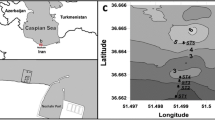Abstract
When waves propagate from deep water to shallow water, wave heights and steepness increase and then waves roll back and break. This phenomenon is called surf. Currently, the present statistical calculation model of surf was derived mainly from the wave energy conservation equation and the linear wave dispersion relation, but it cannot reflect accurately the process which is a rapid increasing in wave height near the broken point. So, the concept of a surf breaking critical zone is presented. And the nearshore is divided as deep water zone, shallow water zone, surf breaking critical zone and after breaking zone. Besides, the calculation formula for the height of the surf breaking critical zone has founded based on flume experiments, thereby a new statistical calculation model on the surf has been established. Using the new model, the calculation error of wave height maximum is reduced from 17.62% to 6.43%.
Similar content being viewed by others
References
Chen Qin. 2006. Fully nonlinear Boussinesq-type equations for waves and currents over porous beds. J Eng Mech, 132(2): 220–230
Chen Qin, Kirby J T, Dalrymple R A, et al. 2000. Boussinesq modeling of wave transformation, breaking, and runup. II: 2D. Journal of Waterway, Port, Coastal and Ocean Engineering, 126(1): 48–56
Cui Cheng, Zhang Ningchuan, Kang Haigui, et al. 2013. An experimental and numerical study of the freak wave speed. Acta Oceanologica Sinica, 32(5): 51–56
Dally W R, Dean R G, Dalrymple R A. 1985. Wave height variation across beaches of arbitrary profile. J Geophys Res, 90(C6): 11917–11927
Erduran K S, Ilic S, Kutija V. 2005. Hybrid finite-volume finite-difference scheme for the solution of Boussinesq equations. International Journal for Numerical Methods in Fluids, 49(11): 1213–1232
Goda Y. 1970. Estimation of the rate of irregular wave overtopping of seawalls. Rept Port Harbour Res Inst, 9(4): 3–41
Goda Y. 1975. Irregular wave deformation in the surf zone. Coastal Eng Jpn, 18: 13–26
Hansen J B, Svendsen I A. 1979. Regular Waves in Shoaling Water: Experimental Data. Denmark: Institute of Hydrodynamics and Hydraulic Engineering, Technical University of Denmark
Kim D H, Lynett P J, Socolofsky S A. 2009. A depth-integrated model for weakly dispersive, turbulent, and rotational fluid flows. Ocean Model, 27(3–4): 198–214
Komar, P D, Gaughan M K. 1972. Airy wave theory and breaker height prediction. Proceedings of Coastal Engineering Conference, 20(1): 405–418
Liang Qiuhua, Marche F. 2009. Numerical resolution of well-balanced shallow water equations with complex source terms. Adv Water Res, 32(6): 873–884
Masch F D. 1964. Conidial waves in shallow water. Coastal Engineering, 9(1): 1–22
Roeber V, Cheung K F, Kobayashi M H. 2010. Shock-capturing Boussinesq-type model for nearshore wave processes. Coast Eng, 57(4): 407–423
Shi Fengyan, Kirby J T, Harris C H, et al. 2012. A high-order adaptive time-stepping TVD solver for Boussinesq modeling of breaking waves and coastal inundation. Ocean Modelling, 43–44: 36–51
Shi Fengyan, Kirby J T, Tehranirad B, et al. 2011. FUNWAVE-TVD, documentation and users’ manual. Research Report, CACR-11-03. Newark, Delaware: University of Delaware
Sunamura T. 1983. Determination of breaker height and depth in the field. Ann Rep, Inst Geosci, Univ Tsukuba, 8: 53–54
Tonelli M, Petti M. 2010. Finite volume scheme for the solution of 2D extended Boussinesq equations in the surf zone. Ocean Eng, 37(7): 567–582
Weggel J R. 1972. Maximum breaker height for design. Proceeding of Coastal Engineering Conference, 21(1): 419–432
Wen Shengchang, Yu Zhouwen. 1984. Wave Theory and Calculation Principle (in Chinese). Beijing: China Science Press, 544–552
You Tao. 2004. Study of the Wave Transformation and Breaking on the Slope and Longshore Currents (in Chinese). Tianjin: Tianjin University Press, 21–32
Zhao Jian, Chen Xueen, Xu Jiangling, et al. 2013. Assimilation of surface currents into a regional model over Qingdao coastal waters of China. Acta Oceanologica Sinica, 32(7): 21–28
Author information
Authors and Affiliations
Corresponding author
Additional information
Foundation item: The National Natural Science Foundation of China under contract Nos 41076048 and 40906044.
Rights and permissions
About this article
Cite this article
Yang, J., Li, X., Zhu, S. et al. A new statistical model of wave heights based on the concept of wave breaking critical zone. Acta Oceanol. Sin. 34, 81–85 (2015). https://doi.org/10.1007/s13131-015-0670-3
Received:
Accepted:
Published:
Issue Date:
DOI: https://doi.org/10.1007/s13131-015-0670-3



